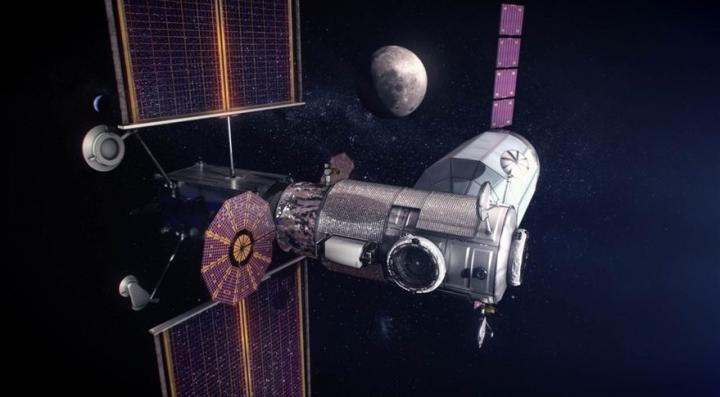15.05.2020

WASHINGTON — NASA is making several changes to its plans to return humans to the surface of the moon by 2024, including launching the first two elements of the lunar Gateway together and adding a critical demonstration to the first crewed Orion flight.
In presentations at a meeting of the NASA Advisory Council’s Human Explorations and Operations Committee May 13, Doug Loverro, NASA associate administrator for human exploration and operations, said the agency had either decided on, or was strongly considering, adopting changes to the initial phase of the Artemis program in order to reduce both cost and risk.
Perhaps the biggest change is the plan for launching the initial elements of the lunar Gateway. Rather than launch the first two modules, the Power and Propulsion Element (PPE) and Habitation and Logistics Outpost (HALO), separately and having them dock in lunar orbit, they will be integrated on the ground and launched on a single rocket.
“That’s both a risk reduction but, more importantly, it’s a huge cost reduction for us,” Loverro said. “We’ve saved a lot of money by going ahead and putting those together on a single launch vehicle, as well as knocked down both technical and operational risk for the program.”
Dan Hartman, program manager for the Gateway, said later in the meeting that combining the two elements saves the cost of one of the two launches originally projected. It also eliminates the requirement for a service module on the HALO it needed for independent power and propulsion capabilities, and for in-space docking of the two elements.
NASA’s new plan calls for launching the combined PPE and HALO modules in November 2023, and using the PPE’s solar electric propulsion system to make its way to lunar orbit over the course of nine to ten months. NASA issued a draft request for proposals for the combined launch earlier in the month, and expects to award a launch contact this fall.
“We validated that we have one launch provider that can do the job,” Hartman said of the Gateway launch. He did not disclose that provider, but it’s believed to be SpaceX and its Falcon Heavy rocket. He also suggested that the ongoing National Security Space Launch Phase 2 competition by the Air Force, which plans to award contracts to two companies this summer, could enable other providers.
While NASA plans to have the Gateway in orbit around the moon by the latter half of 2024, Loverro reiterated previous statements that the Gateway will not be used for the Artemis 3 mission that will attempt to land humans on the moon to “make that mission have a higher probability of success.”
Doing so, he argued, lets NASA focus on demonstrating the ability to land on the surface and reserve the Gateway for use in the later, sustainable phase of lunar expeditions. “We don’t need to take the giant leap all at one time,” he said. “For a future mission, after we demonstrate that we can get to the moon and get a lander to work, we can then have them both dock with the Gateway.”
Eliminating the use of the Gateway for Artemis 3 opens up the possibility of going to a different orbit around the moon than the near rectilinear halo orbit (NRHO) that the Gateway will use. Marshall Smith, director of human lunar exploration programs at NASA, outlined several options under consideration that would bring Orion closer to the moon than NRHO.
None of the other orbits, though, appeared to be clearly better than NRHO. Smith described the effort as looking at alterative orbits “one last time” before permanently setting requirements for the mission and for the lander concepts NASA awarded contracts for last month. “Is there anything that we can do to improve the mission success criteria, to lower the mission risk overall?” he said. “Our goal is to do one last look at this, to see if there’s anything else that we’ve missed.”
NASA is also considering a change to the Artemis 2 mission, the first crewed Orion flight. Loverro said the agency expects to add a “rendezvous and proximity operations,” or RPO, demonstration on that flight, with the Orion spacecraft maneuvering in the vicinity of another spacecraft. The test, though, won’t involve the Gateway or include a docking, since the Orion spacecraft being built for Artemis 2 does not have a docking system.
Loverro said the RPO demonstration is intended to “buy down risk” for future Orion dockings. “We can understand the handling characteristics of Orion and make sure we have the simulators correct on Earth,” he said, as well as test systems needed for future dockings.
Smith said that the target for the RPO demonstration could be the Interim Cryogenic Propulsion Stage, the upper stage of the Space Launch System rocket that launches the mission. Another option is a “co-manifested satellite” launched with Orion.
Some members of the committee warned over the course of the day-long meeting that changing requirements for the program threatened the ability to achieve the 2024 lunar landing goal. Smith said any mission changes would likely be finalized in the next three months. “We’re going close the door at that point.”
Quelle: SN
